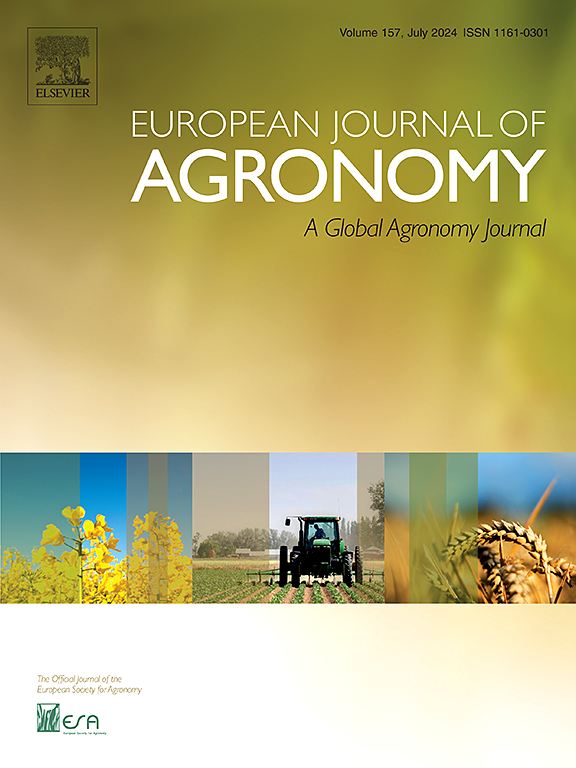CO-ResNetRS50-SSL: Enhanced convolution and semi-supervised learning for accurate rice growth stage recognition in complex field conditions
IF 4.5
1区 农林科学
Q1 AGRONOMY
引用次数: 0
Abstract
Effective crop management decisions, such as fertilization, irrigation, and crop protection, are closely tied to the crop growth stages. Precise identification of development stages is essential to optimize management practices in line with crop needs. While deep learning has shown promise in identifying growth stages, existing models often face challenges due to limited data availability and reduced accuracy in complex field conditions. To overcome these limitations, this study proposes a semi-supervised image classification method built on an enhanced ResNetRS50 architecture, named CO-ResNetRS50-SSL. This model leverages ResNetRS50 as its backbone, integrating Coordinate Attention (CA) for improved positional feature extraction and Omni-Dimensional Dynamic Convolution (ODConv) to enhance the adaptability of convolutional kernels to varying targets. Additionally, a semi-supervised learning framework is employed to boost generalization while minimizing dependence on labeled data. Ablation experiments show that semi-supervised learning boosted ResNetRS50’s accuracy from 88.58 % to 89.36 %. Adding Coordinate Attention further increased accuracy to 89.89 %, while incorporating ODConv in the final CO-ResNetRS50-SSL model achieved 90.38 % accuracy, 90.59 % precision, and 90.19 % F1 score (with 65.38 M parameters). Comparisons reveal that CO-ResNetRS50-SSL outperforms state-of-the-art models (FasterNet-T1, ShuffleNetV2, Swin Transformer, Vision Transformer, ConvNeXt-base) with highly significant differences (p < 0.001) and delivers robust performance across rice growth stages, with an optimal trade-off at 224 × 224 resolution. CO-ResNetRS50-SSL can accurately detect rice growth stages with limited labeled data, and its improvements in accuracy and generalization are expected to enhance decision-making in precision agriculture, optimizing resource allocation, reducing inputs, and advancing progress in the field of digital agriculture. Future work will focus on improving efficiency in utilizing unlabeled data, ensuring more balanced performance across different growth stages, and enhancing the model’s adaptability to other crops and more complex agricultural scenarios.
CO-ResNetRS50-SSL:增强卷积和半监督学习在复杂田间条件下准确识别水稻生育期
有效的作物管理决策,如施肥、灌溉和作物保护,与作物生长阶段密切相关。准确确定发展阶段对于根据作物需求优化管理实践至关重要。虽然深度学习在识别生长阶段方面显示出了希望,但由于数据可用性有限,并且在复杂的现场条件下准确性降低,现有模型经常面临挑战。为了克服这些限制,本研究提出了一种基于增强ResNetRS50架构的半监督图像分类方法,命名为CO-ResNetRS50-SSL。该模型以ResNetRS50为骨干,结合坐标注意(CA)改进的位置特征提取和全维动态卷积(ODConv)增强卷积核对不同目标的适应性。此外,采用半监督学习框架来提高泛化,同时最大限度地减少对标记数据的依赖。消融实验表明,半监督学习将ResNetRS50的准确率从88.58 %提高到89.36 %。在最终的CO-ResNetRS50-SSL模型中加入ODConv,准确率达到90.38 %,准确率达到90.59 %,F1得分达到90.19 %(含65.38 M参数)。比较表明,CO-ResNetRS50-SSL优于最先进的模型(FasterNet-T1, ShuffleNetV2, Swin Transformer, Vision Transformer, ConvNeXt-base),具有非常显著的差异(p <; 0.001),并且在水稻生长阶段提供强大的性能,最佳权衡为224 × 224分辨率。CO-ResNetRS50-SSL可以利用有限的标记数据准确检测水稻生长阶段,其准确性和泛化程度的提高有望增强精准农业决策,优化资源配置,减少投入,推动数字农业领域的发展。未来的工作将侧重于提高未标记数据的利用效率,确保不同生长阶段的性能更加平衡,并增强模型对其他作物和更复杂农业情景的适应性。
本文章由计算机程序翻译,如有差异,请以英文原文为准。
求助全文
约1分钟内获得全文
求助全文
来源期刊

European Journal of Agronomy
农林科学-农艺学
CiteScore
8.30
自引率
7.70%
发文量
187
审稿时长
4.5 months
期刊介绍:
The European Journal of Agronomy, the official journal of the European Society for Agronomy, publishes original research papers reporting experimental and theoretical contributions to field-based agronomy and crop science. The journal will consider research at the field level for agricultural, horticultural and tree crops, that uses comprehensive and explanatory approaches. The EJA covers the following topics:
crop physiology
crop production and management including irrigation, fertilization and soil management
agroclimatology and modelling
plant-soil relationships
crop quality and post-harvest physiology
farming and cropping systems
agroecosystems and the environment
crop-weed interactions and management
organic farming
horticultural crops
papers from the European Society for Agronomy bi-annual meetings
In determining the suitability of submitted articles for publication, particular scrutiny is placed on the degree of novelty and significance of the research and the extent to which it adds to existing knowledge in agronomy.
 求助内容:
求助内容: 应助结果提醒方式:
应助结果提醒方式:


